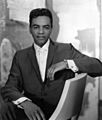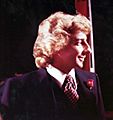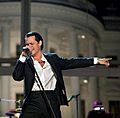Adult contemporary music facts for kids
Quick facts for kids Adult contemporary |
|
|---|---|
| Stylistic origins | |
| Cultural origins | 1960s, United States |
| Subgenres | |
|
|
| Other topics | |
Adult contemporary music (often called AC) is a type of radio popular music. It includes songs from the 1960s to today. This music often has a calm and smooth sound. It mixes styles like soft rock, easy listening, pop, soul, and R&B. AC music grew from the easy listening and soft rock styles that were popular in the 1960s and 1970s.
AC songs usually have a rich, calming, and polished sound. They focus a lot on the melody (the main tune) and harmonies (when different notes sound good together). The music is often catchy but avoids bad words or very complex lyrics. You might hear it as background music in places like supermarkets, shopping malls, or restaurants. Like most pop music, AC songs often follow a simple verse-chorus structure. Many songs are romantic sentimental ballads. They often use acoustic instruments like acoustic guitars, pianos, and saxophones. Sometimes, a full orchestra is used. Modern AC music might also use synthesizers and other electronic sounds.
AC radio stations usually play mainstream music. However, they often avoid hip hop and some types of dance-pop or teen pop. This is because these styles are less popular with adults, who are the main listeners for AC radio. AC radio often aims for listeners aged 25 to 44. These are the people advertisers have focused on since the 1960s. Many AC stations now play more older hits and fewer new songs. This can make the AC music charts change more slowly.
Over time, AC music has created different types, called subgenres. These include "hot AC," "soft AC," "urban AC," "rhythmic AC," and "Christian AC." Some radio stations play only one of these subgenres. Because of this, AC is not always seen as one specific music style. Instead, it's a collection of songs chosen from many different genres.
| Top - 0-9 A B C D E F G H I J K L M N O P Q R S T U V W X Y Z |
How Did Adult Contemporary Music Start?
The Early Days: Easy Listening and Soft Rock in the 1960s

Adult contemporary music began with the easy listening style in the 1960s. This style mostly featured instrumental music, with some singing. In the late 1950s and early 1960s, some radio stations wanted to play popular songs but avoid being called "rock and roll" stations. So, they started the easy listening format.
Billboard magazine first published an Easy Listening chart on July 17, 1961. It listed 20 songs. The first number one song was "Boll Weevil Song" by Brook Benton. The chart aimed for music that was "not too far out."
Early singers included Frank Sinatra, Doris Day, Johnny Mathis, Connie Francis, Nat King Cole, and Perry Como. Stations also played instrumental versions of current pop or rock and roll hits. Sometimes, they even played older big band songs from the 1940s.
After 1965, the Easy Listening chart became very different from the main Hot 100 chart. As rock music became harder, fewer songs crossed over between the two charts. Roger Miller, Barbra Streisand, and Bobby Vinton were very popular on the Easy Listening chart.
One big reason for AC radio was that when rock and roll became popular, many traditional radio stations still wanted to play current hits. But they wanted to avoid rock music. These "middle of the road" (MOR) stations often played older songs from before the rock era. This helped them appeal to adult listeners.
Another reason was the popularity of "beautiful music" stations. This music was made to be calm background music. Most beautiful music was instrumental and not often bought as singles. AC music tried to create a similar "light" sound. It did this by choosing certain songs from popular artists.
Soft Rock Becomes a Radio Style in the 1970s
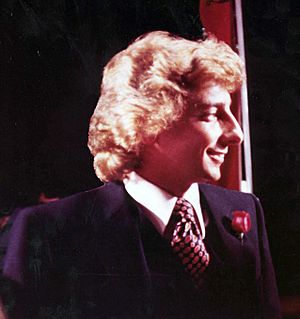
By the late 1960s, hard rock was a clear music style. This led to soft rock and hard rock becoming separate popular types of rock music. Soft rock often came from folk rock. It used acoustic instruments and focused more on melody and harmonies. Important artists included Carole King, Cat Stevens, James Taylor, and Bread.
In the early 1970s, softer songs by The Carpenters, Anne Murray, John Denver, Barry Manilow, and Barbra Streisand started getting more airplay on "Top 40" radio. Top 40 stations played the most popular songs, no matter the style. As Top 40 music became softer, the Hot 100 and Easy Listening/AC charts became more alike.
Easy Listening radio began playing songs by artists who started in other styles, like rock and roll or R&B. Many songs by singer-songwriters like Diana Ross, James Taylor, Carly Simon, Carole King, and Janis Ian were played more on AC stations than on Top 40 stations. AC stations also started playing softer songs by Elvis Presley, Linda Ronstadt, Elton John, Rod Stewart, and Billy Joel. Soon, the AC format began to sound like what it is today. Rock-oriented bands like Chicago and the Eagles became part of the format. Some early disco songs also did well on the Adult Contemporary format.
Soft rock was most popular in the mid-to-late 1970s. Artists like Toto, Air Supply, Seals and Crofts, and Fleetwood Mac were very successful. Fleetwood Mac's album Rumours (1977) was the best-selling album of that decade. By 1977, some radio stations switched to an all-soft rock format. However, different types of popular music, like disco and hard rock, began to appear. This led to special radio stations that played only certain music styles.
Adult Contemporary Becomes a Popular Radio Style in the 1980s
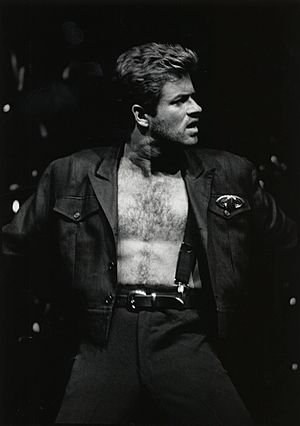
On April 7, 1979, the Easy Listening chart officially changed its name to Adult Contemporary. This name has stayed the same ever since. Adult contemporary music became one of the most popular radio formats in the 1980s. AC grew because the generation that listened to specialized music in the 1970s got older. They were not interested in the heavy metal and rap/hip-hop music that became popular later in the decade.
Mainstream AC music also changed over the years. Traditional AC artists like Barbra Streisand, the Carpenters, Dionne Warwick, Barry Manilow, and Olivia Newton-John found it harder to have big Top 40 hits in the 1980s. Because of MTV, artists popular on Contemporary Hit Radio (CHR) like Richard Marx, Michael Jackson, George Michael, Phil Collins, and Journey started appearing more often on AC charts. Phil Collins has been called "one of the most successful pop and adult contemporary singers of the '80s and beyond." With MTV and AC radio, it became harder to define AC music. Older soft-rock artists still had hits and were played alongside newer mainstream artists.
The number of songs that crossed over between the AC chart and the Hot 100 changed. Not many disco or new wave songs did well on the AC chart in the late 1970s and early 1980s. Also, much of the hip-hop and harder rock music on CHR stations would not have been played on AC radio.
Even though dance-pop and rock ballads were popular in the 1980s, soft rock songs still had some success. Artists like Sheena Easton, Amy Grant, Lionel Richie, Christopher Cross, and Billy Ocean were popular. No song stayed at number one on the AC chart for more than six weeks in the 1980s. Lionel Richie had two songs that reached number one on both the AC and Hot 100 charts: "You Are" in 1983 and "Hello" in 1984.
In 1989, Linda Ronstadt released Cry Like a Rainstorm, Howl Like the Wind. Critics called it "the first true Adult Contemporary album of the decade." It featured soul singer Aaron Neville. The album sold millions of copies in the U.S. and was a big success worldwide. The Grammy Award-winning songs "Don't Know Much" and "All My Life" were long-running number one AC hits. This album helped define AC music and made it more accepted on mainstream radio.
Subgenres and Radio Crossovers in the 1990s
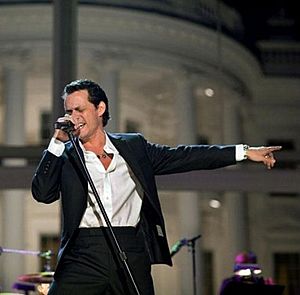
In the early 1990s, urban R&B music became softer, and alternative rock grew. Also, traditional pop music became popular again. This opened up the music market, allowing for more specific music styles. Artists also started making singles that were friendly for AC radio. At the same time, AC music began to use elements from hard rock as people started liking louder music. AC stations also began playing more rock bands.
"Softer" features, like light instrumental music and most pre-1964 artists, were slowly removed from AC radio in the early to mid-1990s.
Unlike most mainstream singers from the 1980s, many 1990s pop/R&B singers crossed over to the AC charts. These included All-4-One, Boyz II Men, Christina Aguilera, Backstreet Boys, and Savage Garden. Latin pop artists like Ricky Martin, Marc Anthony, Selena, and Enrique Iglesias also did well on the AC charts.
Besides Celine Dion, who had great success, other artists with many number one hits on the AC chart in the 1990s included Mariah Carey, Phil Collins, Michael Bolton, Bryan Adams, Whitney Houston, and Shania Twain. Newer female singer-songwriters like Sarah McLachlan, Natalie Merchant, Jewel, and Sheryl Crow also became popular on the AC chart.
In 1996, Billboard created a new chart called Adult Top 40. This chart shows what radio stations play that is between "adult contemporary" and "pop" music. The Adult Contemporary chart and the Adult Top 40 chart are different. A song might be on one chart but not the other. Also, hot AC is a type of radio programming that is different from the Hot Adult Contemporary Tracks chart, even though their names are similar.
To deal with the pressure on Hot AC, a new AC format appeared in American radio. The urban adult contemporary format (a term created by Barry Mayo) usually attracts many African American listeners. It plays a lot of R&B (without rapping), gospel music, classic soul, and dance music (including disco).
Another format, rhythmic AC, plays popular hot and soft AC music from the past and present. It also focuses heavily on disco and 1980s and 1990s dance hits. It includes dance remixes of pop songs, like the Soul Solution mix of Toni Braxton's "Unbreak My Heart."
In its early years, the smooth jazz format was seen as a type of AC. It was mostly instrumental and sounded like soft AC music. For many years, George Benson, Kenny G, and Dave Koz had hits that were played on both smooth jazz and soft AC stations.
AC Music Goes Mainstream (2000s–Present)

In the 2000s, AC music became more important in the music industry. Its radio formats were popular across the country. Smooth jazz and "Urban AC" stations were common on the East Coast. Soft rock and "adult standards" stations were popular in the Midwest. Pop-oriented "Hot AC" and "world music"/Hispanic AC stations were found on the West Coast. This led to many different music styles appearing on the AC charts. These songs often crossed over to the "pop" charts. This helped define AC music and made it more accepted on mainstream radio.
Josh Groban's song "You Raise Me Up" and Michael Bublé's cover of "Fever" are good examples of the high-quality production and ballad-heavy sound of 2000s AC. This style was often called "jazz-pop" and had influences from classical, jazz, and traditional pop music. Artists like James Blunt, John Mayer, Norah Jones, and Susan Boyle also became very successful during this time. In the 2000s, country music artists like Kelly Clarkson, Shania Twain, and Carrie Underwood had hits on soft AC stations, especially in Southern states. A popular trend was remixing dance music hits into adult contemporary ballads.
A key reason for AC's success in the 2000s was the 25–34 age group. They had grown out of the pop music of the time. Most new rock was too alternative and harsh for AC radio. Most new pop was heavily influenced by dance-pop, hip-hop, and electronic dance music. At the same time, the music industry started focusing on older audiences and "niche" markets.
In the late 2000s, some pop songs started appearing on the AC charts. This usually happened after they had left the Hot 100 chart. Adrian Moreira, a senior vice president for RCA Music Group, said, "We've seen a fairly tidal shift in what AC will play." Instead of focusing on older songs, adult contemporary began playing many of the same songs as top 40 and adult top 40. But they played them only after the hits were already popular. Corey Moss from MTV described this trend: "AC stations are where pop songs go to die a very long death. Or, to optimists, to get a second life." Since adult contemporary has always been family-friendly, "clean" versions of pop songs started appearing on the AC chart. Examples include "Perfect" by P!nk and "Forget You" by Cee Lo Green in 2011.
AC radio shifted to more mainstream pop because of changes in broadcasting after the 2005–2007 economic downturn. Advertisers preferred more profitable chart-based formats. This led to the end of many AC-based styles, especially those for older audiences. Music tastes among all age groups also changed towards more modern music. Fewer physical record sales in the 2010s also hurt the AC genre. There are also worries that the portable people meter, a device used to track radio listening, might not accurately pick up AC songs because of their sound.
Key AC artists in the early to mid-2010s included Bruno Mars, Coldplay, Adele, Meghan Trainor, Maroon 5, and Ed Sheeran. Their music was more pop-influenced and upbeat than earlier AC songs. It also had sounds like the Motown sound and the Wall of Sound from the 1960s. In the early 2010s, alternative and indie rock bands like Wilco, Imagine Dragons, and Mumford & Sons became AC favorites. Later, they were replaced by rhythm-based rock bands like Panic! at the Disco, Twenty One Pilots, and Walk the Moon.
In the middle of the decade, newer artists like OneRepublic, Rachel Platten, Shawn Mendes, Sia, and Sam Smith were added to most AC stations. Also, artists popular in the 1990s and early 2000s, like Britney Spears and Christina Aguilera, were played.
As trap music and similar hip-hop styles became popular on top 40 stations in the late 2010s, AC stations started playing rhythmic artists like Rihanna, Lady Gaga, and Pitbull. They also played EDM artists like Avicii, Daft Punk, and David Guetta. Meanwhile, younger artists like Camila Cabello, Justin Bieber, Selena Gomez, and Ariana Grande began to be featured more on AC stations than on top 40 stations.
Different Types of Adult Contemporary Radio
In radio, adult contemporary is divided into several sub-formats. Each has its own music style and target audience. Hot adult contemporary formats usually play recent hits that appeal to many adults. A station called "adult contemporary" (without any extra words) usually has a similar playlist to hot AC stations. But it also plays more classic hits from past decades.
Soft adult contemporary formats have a calmer sound. They are mainly for adult women. Urban AC focuses on R&B and soul music for African American adults. Rhythmic AC focuses on dance music and other rhythmic styles.
Hot Adult Contemporary (Hot AC)
Hot adult contemporary (hot AC) radio stations play a wide range of today's popular music. This appeals to people aged 18 to 54. It's a middle ground between youth-focused contemporary hit radio (CHR) and other adult contemporary formats. Hot AC stations usually play upbeat hit music that many people like, such as pop and pop rock songs. They avoid music aimed more at young people, like hip-hop. Older songs played on hot AC usually include familiar music that adults grew up with. Also, songs from pop artists like the Backstreet Boys, Jason Mraz, and Pink have been popular on this format.
The "hot AC" name appeared in the 1990s. It described AC stations that sounded more energetic and upbeat than softer ones. An early example was Houston's KHMX Mix 96.5. It quickly became very popular. Many other stations copied its style. Many hot AC stations are among the most popular in their areas.
At first, hot AC focused more on pop rock. But it has changed to fit its audience. By the mid-2000s, it included more upbeat pop music. In the 2010s, alternative and indie rock songs that crossed over to pop charts also became common.
These changes helped hot AC become popular with younger listeners, like millennials. Nielsen Audio said hot AC was the third most popular format among millennials. It was behind only pop and country music. Dana Taylor, a program director for WOMX-FM, said that hot AC stations "may not be the radio station that everybody agrees on, but it's a radio station that everybody goes, 'I'm okay with that'." Pop hits becoming slower in the mid-to-late 2010s also helped attract more listeners.
Hot AC stations usually keep more recent hits in rotation than stations that strictly follow charts, like CHR. Since CHR stations focus only on current hits, hot AC airplay can help a song stay popular for a long time. This has helped new artists like Adele and Rachel Platten ("Fight Song") become popular.
The popularity of hot AC led many mainstream AC stations to add upbeat music to their playlists. They still kept more older hits than hot AC stations.
Modern Adult Contemporary
Modern adult contemporary means AC formats that lean more towards modern rock and pop rock.
In the 1990s and early 2000s, modern AC was usually for women. Mike Marino of KMXB in Las Vegas said it reached "an audience that has outgrown the edgier hip-hop or alternative music but hasn't gotten old and sappy enough for the soft ACs." This format usually focused on female rock artists like Shawn Colvin, Sheryl Crow, and Sarah McLachlan. It also included folk rock-influenced bands like Counting Crows. Today, this format is not very common. KTCZ in the Minnesota Twin Cities is one of the few modern AC stations left.
Soft Adult Contemporary (Soft AC)
The Soft adult contemporary format usually targets women aged 25 to 54 and people listening at work. Soft AC playlists are generally calmer than hot AC. They focus on pop and power ballads, soft rock, and other familiar, light hits. When it started in the 1980s, soft AC was meant to be a more upbeat version of easy listening. It aimed to appeal to younger listeners by not playing instrumental beautiful music. Easy listening stations began changing to this format because they worried their old music wouldn't appeal to new listeners.
In 1990, James Warren of the Chicago Tribune said soft AC stations were "as middle-of-the-road and unthreatening as modern media get." The people who worked at these stations were encouraged to be inoffensive and "low-profile." Their music library was calmer than hot AC stations. For example, Chicago's WLIT did not have its hosts talk over the beginning and end of songs. It played Bob Seger's "We've Got Tonite" but not "Old Time Rock and Roll." The director of a soft AC station in Connecticut, WEZN-FM, said he stopped reading news headlines. He didn't want listeners to switch to an all-news station.
Soft AC stations are often very careful about their music. They prefer proven songs over current hits. When the format became popular, core artists included singers like Nat King Cole, Perry Como, Neil Diamond, Barry Manilow, and Barbra Streisand. By the 1990s, some soft AC stations started playing music from contemporary artists from the 80s and 90s. These included Bon Jovi, Bryan Adams, Celine Dion, Mariah Carey, Whitney Houston, and Queen. However, by 1996, New York's WLTW began to play less soft music and more upbeat songs.
In 2017, Inside Radio reported that soft AC had the third-largest decrease in U.S. stations. This was due to older listeners and a big increase in the wider-appealing classic hits format. Consultant Gary Berkowitz said that soft AC had become less important compared to mainstream and hot AC. This was because PPM markets preferred upbeat music.
However, soft AC began to become popular again. In April 2016, iHeartMedia changed its San Francisco classic soul station KISQ to soft AC, calling it The Breeze. By November 2018, it was the top station in the Bay Area. This trend continued, with iHeartMedia and other companies using the Breeze brand for soft AC stations. Industry analyst Sean Ross said that older listeners were becoming more valuable. This is because younger audiences prefer digital platforms like music streaming services over traditional radio.
Current soft AC stations still play songs by artists like Michael Bolton, Celine Dion, Elton John, Fleetwood Mac, and Whitney Houston. Modern artists like Adele and Michael Bublé have also become common on this format. The soft AC sound has also become more varied. It now includes more songs that are "safe and universal" and not just "soft." Examples include Simple Minds' "Don't You (Forget About Me)" and the style called yacht rock. Over time, some stations have started playing more songs from the 1980s and 1970s.
Urban Adult Contemporary (Urban AC)
The Urban adult contemporary format mainly focuses on current and classic R&B and soul music. This format usually targets African-American adults. In July 2018, Nielsen Audio reported it as the top format among African-Americans aged 25–54 and 35–64. It is also quite popular with younger listeners. It was the second-most popular format among African-American adults aged 18–34.
This format usually does not play youthful rhythmic music, like commercial hip-hop and rap. These are usually found on the urban contemporary format. The urban AC format is also linked to "quiet storm"—calmer R&B ballads and slow jams, often with a jazz influence. The syndicated evening show Keith Sweat Hotel plays this type of music.
Since urban contemporary stations prefer hit-driven hip-hop songs, music labels usually send R&B songs only to the urban AC format. Some R&B musicians have said this creates an unfair divide. It stops them from reaching a wider audience. This is because there are fewer urban AC stations compared to urban and rhythmic stations. Some artists have tried to distance themselves from "R&B" to avoid this problem. However, streaming services have helped R&B reach more people beyond urban AC radio.
Rhythmic Adult Contemporary (Rhythmic AC)
The Rhythmic adult contemporary format generally focuses on different types of current and classic dance music. This includes dance-pop, hip-hop, and R&B. It often sounds like a mix of Classic hits and hot AC formats. The exact mix of current and older songs can change depending on the local culture and the history of rhythmic formats in the area. It can range from late-80s/early-90s dance hits to disco and Motown. Rhythmic hot AC has also been used as a format, made popular by stations like New York's WKTU.
Smooth Adult Contemporary (Smooth AC)
The Smooth adult contemporary format is a type of smooth jazz. It includes mainstream and/or urban adult contemporary songs. These stations are designed to appeal to more people than a pure smooth jazz format. Some smooth AC stations might only play jazz instrumental songs by very well-known artists like Kenny G.
Christian Adult Contemporary (Christian AC)
Contemporary Christian music (CCM) has several subgenres, and one is "Christian AC." Radio & Records, for example, lists Christian AC among its format charts. Many core artists of the Christian AC genre have also had success on mainstream and hot AC formats. These include Amy Grant, Michael W. Smith, Steven Curtis Chapman, Lauren Daigle, MercyMe, and Newsboys.
Adult Album Alternative (Triple-A or AAA)
The Adult album alternative (triple-A or AAA) format usually plays a wide variety of music for adults. It focuses on new songs and artists, often playing songs that were not released as singles. The exact music played on a triple-A station can vary. alternative rock, indie rock, and indie pop are common core genres. Some stations also play less common styles like alternative country, Americana, blues, folk music, and world music. NPR noted in 2018 that about half of all triple-A stations in the U.S. were non-commercial stations. Because of the wide variety of music, adult album alternative charts have often helped songs become popular on the Adult Top 40 chart. They have also helped new artists like Dave Matthews Band and Lorde become famous.
Christmas Music on AC Radio
Since the 1990s, it has become common for many AC stations, especially soft AC stations, to play mostly or only Christmas music during the Christmas season (November and December). These songs are usually modern holiday recordings by the same artists played normally. But most stations also play some older holiday tunes from pop, MOR, and adult standards artists. These include The Carpenters, Nat King Cole, Bing Crosby, Johnny Mathis, and Andy Williams. Many of these artists would not be played on these stations during the rest of the year.
These Christmas music marathons usually start a few weeks before Thanksgiving Day and end after Christmas Day, or sometimes on New Year's Day. After that, the stations go back to their regular music. Some stations start the holiday music much earlier, at the beginning of November, especially after Halloween. This tradition started with the beautiful music and easy listening stations of the 1960s and 1970s.
Radio Shows and Networks with Adult Contemporary Music
- Delilah – One of the most popular radio shows in the U.S. It airs mostly in the evening. Its Christmas Edition plays from mid-November to late December.
- Intelligence for Your Life – Hosted by John Tesh. This show also airs in the evenings and on weekends.
- American Top 40 with Ryan Seacrest – One version of AT40 airs on U.S. hot AC stations. It is a little different from the Top-40/CHR version.
- Rick Dees Weekly Top 40/Weekly Top 30 – Started offering Hot AC versions in June 1996. These shows feature the top 20 Hot AC songs in the U.S. along with about 10 past hits from the 1980s, 1990s, and early 2000s. A softer "AC" version was added in July 2009.
- Radio Disney Music Top 30 Countdown – One version is for Hot AC stations, and another is for Mainstream AC stations. It plays the USA Top 30 songs of the week. This show is distributed by Compass Media Networks.
- Backtrax USA with Kid Kelly – Weekend shows focusing on the '80s and '90s, for hot AC stations.
- ABC and Dial Global both offer 24-hour AC networks playing soft and hot AC.
- Tom Joyner and Steve Harvey have popular morning shows that air on urban AC (and sometimes Hip-Hop) stations.
- Retro Rewind with Dave Harris – A weekend radio show with many songs from the 1980s and 1990s. It includes interviews, spotlights, and contests. The show is live across the U.S. on Saturday nights and takes audience requests. It is for HOT AC and AC radio stations.
- The EZ Rock network – A brand/network of soft AC heard in Canada.
- Heart – A radio network in the UK that grew in 2009.
- Smooth Radio – A UK-wide radio network.
- Smoothfm – A network of two Australian radio stations in Sydney and Melbourne. They play an eclectic easy-listening playlist, usually with ballads.
- Nova – A network of five Australian radio stations in Sydney, Melbourne, Brisbane, Adelaide, and Perth. They are very similar to Smoothfm.
- The Breeze – A group of New Zealand adult contemporary radio stations owned by MediaWorks Radio. There are 20 stations broadcasting throughout New Zealand.
- The Bob and Sheri Show – An American morning show based in Charlotte, North Carolina. It is heard on more than 50 AC stations and the American Forces Network.
Former syndicated programs included Dick Clark's US Music Survey (1996–2005), Casey's Hot 20/Casey's Countdown/American Top 20/10 (1992–2009), and Top 30 USA.
See Also
 In Spanish: Adult contemporary para niños
In Spanish: Adult contemporary para niños
- Adult Contemporary, a chart in Billboard since 1961. This chart is usually closer to soft AC.
- New-age music
- Yacht rock
Images for kids
-
Johnny Mathis concentrated on romantic readings of jazz and pop standards for the adult contemporary audience of the 1960s and 1970s.
-
In terms of record sales and career longevity, Barry Manilow is one of the most successful adult contemporary singers ever and the most best-selling of the 1970s.
-
"Careless Whisper" stayed at the No. 1 spot in the adult contemporary chart for 5 weeks. The song was George Michael's first solo single.
-
Latin artist Marc Anthony's self-titled English-language album released in 1999 had singles that crossed over to the AC charts.
-
A number of Michael Bublé's singles and albums topped the AC charts in the 2000s and 2010s.


